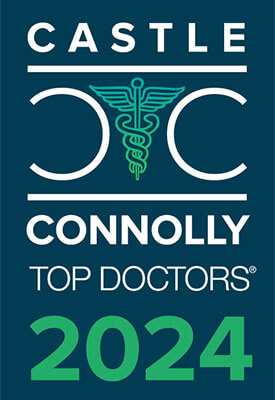What Happens In a Thrombectomy?

Thrombectomy is a life-saving procedure aimed at removing blood clots (thrombi) that obstruct blood vessels. This minimally invasive technique has gained popularity due to its effectiveness in treating various critical conditions, particularly acute ischemic strokes, myocardial infarctions (heart attacks) and pulmonary embolisms.
New York Vascular Surgeon Alan Benvenisty, MD, explores the details of what happens during a thrombectomy, how it is performed, the conditions it addresses and answers some commonly asked questions about the procedure.
Understanding Thrombectomy
Thrombectomy involves the delicate process of using image guidance to navigate a thin catheter through the body’s vascular system to the site of the blood clot. By either retrieving or aspirating the clot, this procedure aims to restore normal blood flow and prevent further complications.
- The New England Journal of Medicine published an article in 2024 that stated: “Among patients with large ischemic strokes, endovascular thrombectomy resulted in better functional outcomes than medical care.”
- A December 2024 article in Clinical Neurology and Neurosurgery revealed that “Patients treated with EVT (Endovascular Thrombectomy) after 24 hours have comparable safety and effectiveness to those treated within 24 hours.”
As a board-certified general surgeon with special qualifications in vascular surgery, Dr. Benvenisty approaches thrombectomy with the understanding that no two patients are alike. Every individual case brings unique challenges and considerations, and he always prioritizes an informed, conservative approach to ensure the best care for his patients.
Indications for Thrombectomy
While thrombectomy is most commonly associated with the treatment of acute ischemic strokes, it is also beneficial in other serious conditions. Here are a few scenarios where thrombectomy may be indicated:
- Acute Ischemic Stroke: When blood flow to the brain is blocked by a clot, timely intervention is critical. Thrombectomy can quickly remove the obstruction, potentially reversing neurological damage.
- Myocardial Infarction: Clots that obstruct blood flow to the heart can lead to heart attacks. A thrombectomy can help restore blood flow, minimizing damage to the heart muscle.
- Pulmonary Embolism: In cases where a blood clot travels to the lungs, causing a blockage, thrombectomy can be a lifesaving procedure to remove the clot and restore circulation.
The Thrombectomy Procedure
The thrombectomy process can be broken down into several important steps:
- Preparation: Patients typically receive anesthesia and may be given medication to prevent blood clotting. This step is essential for ensuring comfort throughout the procedure.
- Accessing the Blood Vessel: A small incision is made, usually in the groin or wrist, to access a major artery. A thin catheter is then carefully threaded through the blood vessel to the site of the clot.
- Image Guidance: Imaging techniques such as fluoroscopy or ultrasound are utilized to visualize the clot and guide the catheter accurately.
- Removing the Clot: There are two common techniques for removing the clot:
Stent Retrieval: A stent-like device is deployed to capture the clot, which is then pulled back through the catheter.
Aspiration: A suction mechanism is used to aspirate the clot from the vessel. - Restoring Blood Flow: Once the clot is successfully removed, blood flow is restored and the catheter is withdrawn from the bloodstream. The incision site is closed, and the patient is monitored during recovery.
Frequently Asked Questions About Thrombectomy
Is thrombectomy safe?
Yes, thrombectomy is a safe and effective procedure when performed by experienced vascular specialists. Like any medical procedure, there are risks, but the benefits often outweigh them, especially in life-threatening situations.
How long does the procedure take?
The duration of a thrombectomy can vary based on the complexity of the case. Generally, the procedure can take from 30 minutes to a few hours, depending on factors such as clot size and location.
What is the recovery process like?
Recovery from a thrombectomy typically involves a short hospital stay. Patients are monitored for complications, and many can return to normal activities fairly quickly, although full recovery may take time based on the individual’s health and the condition being treated.
Will I need follow-up care?
Yes, follow-up appointments are crucial for monitoring recovery and assessing vascular health. Your vascular surgeon will provide a personalized plan based on your condition.
Are there alternatives to thrombectomy?
Patients may have alternative treatments available, such as medication to dissolve clots, but thrombectomy is often the preferred option when immediate action is needed to restore blood flow.
NYC Minimally Invasive Endovascular Thrombectomy
The thrombectomy process is a remarkable testament to advances in medical technology and surgical techniques, providing hope and healing for patients dealing with severe vascular blockages. As a dedicated vascular surgeon, Dr. Benvenisty emphasizes personalized care and informed decision-making, ensuring that patients fully understand their options and the steps they will take together toward better vascular health.
If you have further questions or would like to discuss your own vascular health, please feel free to reach out for a consultation. Your health is a priority, and we are here to guide you through your treatment journey.
Posted on behalf of
440 West 114th St, Second Floor
New York, NY 10025
Phone: (212) 523-4706
Monday & Friday 9:00 AM – 5:00 PM







